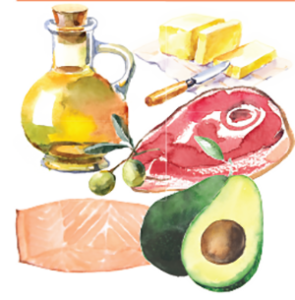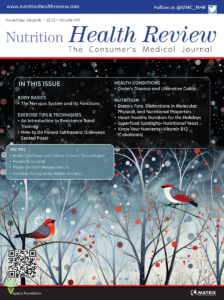 by Aliza Becker, BA, MPS
by Aliza Becker, BA, MPS
Dietary fat provides the body with fatty acids that influence the metabolism, function, and responsiveness of cells and tissues to hormonal and other signals.1 However, not all dietary fats are equal. First, although all fats include a chain of carbon atoms bonded to each other and to hydrogen atoms, the length and shape of the carbon chain and the number of hydrogen atoms vary among them.2 A longer carbon chain length results in a higher melting point and a fat that is more solid at room temperature, and a carbon chain that is filled to capacity with hydrogen atoms (as opposed to containing ≥1 double bonds between carbon atoms) results in a fat that is “saturated.”3 As such, saturated and trans fats are generally solid at room temperature, raise the body’s low-density lipoprotein cholesterol (LDL-C) level, and are considered unhealthy.4 Conversely, mono- and polyunsaturated fats are liquid at room temperature and lower the LDL-C level in the body.4
How the Body Processes Fat
Fat digestion begins in the mouth, where the enzyme lingual lipase primes triacylglycerols (triglycerides) and other lipid compounds for digestion.5 All fats are consumed in the diet as triacylglycerols, which are composed of three fatty acids of varying lengths and compositions esterified to a glycerol molecule. In the stomach, gastric lipase begins breaking the primed triacylglycerols into diglycerides and fatty acids; however, the majority of fat digestion ultimately occurs in the intestines.5 As the stomach contents enter the small intestine, persisting fat compounds are combined with watery fluids from the body using bile as an emulsifier to increase their surface area and make them more accessible to the digestive enzymes.5 Pancreatic lipase then breaks down these remaining fats into free fatty acids and monoglycerides, and bile salts envelop the aforementioned fat components to form micelles, which are able to pass through the watery mucous layer coating the absorptive lining of the digestive tract.5 The free fatty acids and monoglycerides are then subsequently released from the micelles and enter the cells of the digestive tract lining, where they reassemble into triacylglycerols that combine with cholesterol and phospholipids as well as a protein carrier to become lipoproteins.5 These lipoproteins enter the lymphatic system and are released into the bloodstream via the jugular vein in the neck, which transports them to various locations for use or storage in adipose tissue.5
Sources and Intake Guidelines
Trans fat, considered the “worst” type of fat, is a byproduct of the hydrogenation process used to convert liquid vegetable oil into a solid fat at room temperature. With no known health benefits, its use has been banned in the United States since January 2020.6 Some amount of trans fat occurs naturally in food products from ruminant animals, such as milk, butter, cheese, and meat products.6 Food sources of saturated fat include red meat, whole milk, cheese, coconut oil, and commercially prepared baked goods.2
Both mono- and polyunsaturated fats are found in plant oils, nuts, and seeds, although certain foods are better sources of one or the other. Olive, peanut, and canola oils; almonds, hazelnuts, and pecans; and pumpkin and sesame seeds offer high concentrations of monounsaturated fat. Good sources of polyunsaturated fat include sunflower, corn, soybean, and flaxseed oils; walnuts; and flax seeds.7 Additionally, avocado is a good source of monounsaturated fat, while fish is a good source of polyunsaturated fat.7
The United States (US) Food and Drug Administration (FDA)’s daily reference values for total fat intake based on a 2,000-calorie diet are 78 grams for adults (including pregnant women) and children four years of age or older, and 39 grams for children 1 to 3 years of age.8 For saturated fat, these numbers are 20 grams and 10 grams, respectively.8 The most recent US Dietary Guidelines for Americans recommends limiting saturated fat intake to 10 percent of total calories consumed.9 The National Cholesterol Education Program has suggested saturated fats should comprise less than seven percent of total calories, whereas poly- and monounsaturated fats should comprise no more than 10 percent and 20 percent of total calories consumed, respectively.10
Fat Consumption and Health
Perhaps the most well-known consequence of fat consumption is that saturated fats can cause cardiovascular disease (CVD); this was first voiced in the 1950s by physiologist Ancel Keys, whose “diet–heart hypothesis” subsequently gained widespread acceptance in the 1970s and ‘80s with the publication of several large international studies supporting this association.11 Newer research suggests, however, that the strength of this relationship is uncertain.11 For example, nine meta-analyses of observational data conducted between the years 2010 and 2021 found no significant associations between the consumption of saturated fat and coronary heart disease (CHD).11 In addition, a systematic review published in 2020 by the Cochrane group, a British international charitable organization formed to organize medical research findings, reported that a reduction in dietary saturated fats reduced CVD events but had no effect on total mortality, CVD mortality, CHD mortality, fatal heart attacks, non-fatal heart attacks, or CHD events.12 Moreover, simply reducing one’s saturated fat intake does not automatically lead to improved cardiovascular health;13 for example, a large Danish prospective cohort study concluded that, when saturated fat was replaced with high–glycemic index (GI) carbohydrates, the risk of myocardial infarction increased by 33 percent.14 Replacing saturated fats instead with mono- and especially polyunsaturated fats, however, can reduce LDL-C and total cholesterol levels, increase the high-density lipoprotein (good) cholesterol level, and reduce triglyceride levels.15
Obesity is another major adverse health result of excessive fat consumption. Although some amount of dietary fats needs to be consumed to obtain the fatty acids crucial for body functions—including the essential fatty acids omega-3 and omega-6, which can only be obtained through food16—an overabundance of triacylglycerols results in their deposition in adipose tissue through removal from lipoproteins, breakdown into fatty acids and glycerol, and intracellular reassembly.5 Similarly, the intake of too many carbohydrates leads to an overabundance of glycogen in the muscles, which is returned to the liver, converted into triacylglycerols, and then stored as fat.5 Moreover, dietary fat has a weaker effect on satiation,17 leading to a greater risk of passive overconsumption and a greater energy density than carbohydrates or protein do,18 which can result weight gain. However, although the intake of saturated fat should be limited as a general rule, certain saturated fats may be worse offenders than others. Following food consumption, long-chain saturated fats like palmitate and stearate (found in various animal products) are more likely to be stored in adipose tissue, while medium-chain saturated fats like lauric acid (found in coconuts) and monounsaturated fats may be more likely to be burned for energy.19
Greater daily total fat intake levels, especially over 65 grams, may significantly increase the risk of ischemic stroke.20 Conversely, some research suggests that a greater intake of saturated fats can reduce risk of stroke.21,22 Greater intake of saturated and trans fats may increase the risk for cognitive disorders, such as Alzheimer’s disease,23,24 and inverse associations between a high intake of monounsaturated fat and a high ratio of polyunsaturated to saturated fat intake and cognitive decline have been reported.24
A variety of studies suggest that saturated fat can impact immune system function. In macaques, a diet high in saturated fat and cholesterol led to significantly more rapid progression of immunodeficiency virus disease.25 Individuals with asymptomatic severe acute respiratory syndrome coronavirus 2 infection reported a lower intake of saturated fat than symptomatic individuals.26 A high-fat diet may also be a risk factor for the development of influenza A virus–associated cardiovascular damage.27 Mouse research has determined that saturated fat may stimulate macrophages to secrete interleukin-1β, a driver of diet-induced tissue inflammation.28 Finally, the percentage of overactive T-cells was increased in mice fed a Western-style high-fat diet for nine weeks, which is a characteristic of autoimmune disease.29
What’s Keto?
When the body requires energy, it turns first to carbohydrates (which provide glucose) and then to fat if the carbohydrate supply has been exhausted. As such, availability of an adequate amount of carbohydrates means that any fat consumed in the diet will instead be stored in the body. In response, the ketogenic diet, although first used to treat epilepsy in 1921, has experienced a resurgence in popularity in recent years.30 The diet plan for the keto diet stipulates the consumption of high fat and very low carbohydrate concentrations alongside a moderate amount of protein to force the body to ultimately enter a state of ketogenesis, where it relies on ketone bodies as an alternate source of energy due to the unavailability to glucose.30 This diet may have positive effects on health, such as transient reductions in blood pressure, triglycerides, and glycosylated hemoglobin values, together with weight loss and increases in high-density lipoprotein cholesterol levels within the first 6 to 12 months; however, concomitant increases in LDL-C and very-low-density lipoprotein cholesterol may increase the cardiovascular risks.31 The diet may also be unsustainable for some due to the dietary restrictions required to sustain ketosis.31
Sources
1. Calder PC. Functional roles of fatty acids and their effects on human health. J Parenter Enteral Nutr. 2015;39(1 Suppl):
18S–32S.
2. Harvard Health Publishing. Harvard Medical School. The truth about fats: the good, the bad, and the in-between. https://www.health.harvard.edu/staying-healthy/the-truth-about-fats-bad-and-good. Accessed March 11, 2022.
3. How lipids work. In: University of Hawai’i at Mānoa Food Science and Human Nutrition Program. Human Nutrition [Depreciated]. Honolulu, Hawai’i: University of Hawai’i at Mānoa. http://pressbooks-dev.oer.hawaii.edu/humannutrition/chapter/how-lipids-work/. Accessed March 13, 2022.
4. Bhandari P, Sapra A. Low fat diet. [Updated 2022 Feb 10]. In: StatPearls [Internet]. Treasure Island, FL: StatPearls Publishing; 2022.
5. Digestion and absorption of lipids. In: University of Hawai’i at Mānoa Food Science and Human Nutrition Program. Human Nutrition [Depreciated]. Honolulu, Hawai’i: University of Hawai’i at Mānoa. http://pressbooks-dev.oer.hawaii.edu/humannutrition/chapter/digestion-and-absorption-of-lipids/. Accessed March 13, 2022.
6. United States Food and Drug Administration. Trans fat. https://www.fda.gov/food/food-additives-petitions/trans-fat. Accessed March 14, 2022.
7. Harvard T.H. Chan School of Public Health. Types of fat. https://www.hsph.harvard.edu/nutritionsource/what-should-you-eat/fats-and-cholesterol/types-of-fat/. Accessed March 13, 2022.
8. United States Food and Drug Administration. Frequently asked questions for industry on nutrition facts labeling requirements. https://www.fda.gov/media/99059/download. Accessed March 13, 2022.
9. United States Department of Agriculture. Dietary Guidelines for Americans 2020–2025. https://www.dietaryguidelines.gov/sites/default/files/2021-03/Dietary_Guidelines_for_Americans-2020-2025.pdf. Accessed March 15, 2022.
10. Expert Panel on Detection, Evaluation, and Treatment of High Blood Cholesterol in Adults. Executive summary of the Third Report of The National Cholesterol Education Program (NCEP) Expert Panel on Detection, Evaluation, and Treatment of High Blood Cholesterol in Adults (Adult Treatment Panel III). JAMA. 2001;285(19):2486–2497.
11. Astrup A, Teicholz N, Magkos F, et al. Dietary saturated fats and health: are the U.S. guidelines evidence-based? Nutrients. 2021;13(10):3305.
12. Hooper L, Martin N, Jimoh OF, et al. Reduction in saturated fat intake for cardiovascular disease. Cochrane Database Syst Rev. 2020;5(5):CD011737.
13. Siri-Tarino PW, Chiu S, Bergeron N, Krauss RM. Saturated fats versus polyunsaturated fats versus carbohydrates for cardiovascular disease prevention and treatment. Annu Rev Nutr. 2015;35:517–543.
14. Jakobsen MU, Dethlefsen C, Joensen AM, et al. Intake of carbohydrates compared with intake of saturated fatty acids and risk of myocardial infarction: importance of the glycemic index. Am J Clin Nutr. 2010;91(6):1764–1768.
15. Mensink RP, Katan MB. Effect of dietary fatty acids on serum lipids and lipoproteins. a meta-analysis of 27 trials. Arterioscler Thromb. 1992;12(8):911–919.
16. Nonessential and essential fatty acids. In: University of Hawai’i at Mānoa Food Science and Human Nutrition Program. Human Nutrition [Depreciated]. Honolulu, Hawai’i: University of Hawai’i at Mānoa. http://pressbooks-dev.oer.hawaii.edu/humannutrition/chapter/nonessential-and-essential-fatty-acids/. Accessed March 13, 2022.
17. Blundell JE, MacDiarmid JI. Fat as a risk factor for overconsumption: satiation, satiety, and patterns of eating. J Am Diet Assoc. 1997;97(7 Suppl):S63–S69.
18. Rolls BJ. The role of energy density in the overconsumption of fat. J Nutr. 2000;130(2S Suppl):268S–271S.
19. DiNicolantonio JJ. Good fats versus bad fats: a comparison of fatty acids in the promotion of insulin resistance, inflammation, and obesity. Mo Med. 2017;114(4):303–307.
20. Boden-Albala B, Elkind MSV, White H, et al. Dietary total fat intake and ischemic stroke risk: the Northern Manhattan Study. Neuroepidemiology. 2009;32(4):296–301.
21. Kang Z-Q, Yang Y, Xiao B. Dietary saturated fat intake and risk of stroke: systematic review and dose-response meta-analysis of prospective cohort studies. Nutr Metab Cardiovasc Dis. 2020;30(2):179–189.
22. Cheng P, Wang J, Shao W, et al. Can dietary saturated fat be beneficial in prevention of stroke risk? a meta-analysis. Neurol Sci. 2016;37(7):1089–1098.
23. Barnard ND, Bunner AE, Agarwal U. Saturated and trans fats and dementia: a systematic review. Neurobiol Aging. 2014;35 Suppl 2:S65–S73.
24. Morris MC, Evans DA, Bienias JL, et al. Dietary fat intake and 6-year cognitive change in an older biracial community population. Neurology. 2004;62(9):1573–1579.
25. Mansfield KG, Carville A, Wachtman L. A diet high in saturated fat and cholesterol accelerates simian immunodeficiency virus disease progression. J Infect Dis. 2007;196(8):1202–1210.
26. Ponzo V, Pellegrini M, D’Eusebio C, et al. Mediterranean diet and SARS-COV-2 infection: is there any association? a proof-of-concept study. Nutrients. 2021;13(5):1721.
27. Siegers JY, Novakovic B, Hulme KD, et al. A high-fat diet increases influenza A virus-associated cardiovascular damage. J Infect Dis. 2020;222(5):820–831.
28. Robblee MM, Kim CC, Abate JP, et al. Saturated fatty acids engage an IRE1α-dependent pathway to activate the NLRP3 inflammasome in myeloid cells. Cell Rep. 2016;14(11):2611–2623.
29. Pollock AH, Tedla N, Hancock SE, et al. Prolonged intake of dietary lipids alters membrane structure and T cell responses in LDLr-/- mice. J Immunol. 2016;196(10):
3993–4002.
30. Masood W, Annamaraju P, Uppaluri KR. Ketogenic diet. [Updated 2021 Nov 26]. In: StatPearls [Internet]. Treasure Island, FL: StatPearls Publishing; 2022.
31. Batch JT, Lamsal SP, Adkins M, et al. Advantages and disadvantages of the ketogenic diet: a review article. Cureus. 2020;12(8):e9639.
 About the Author
About the Author
Ms. Becker is the managing editor of The Journal of Innovations in Cardiac Rhythm Management. She also works as a freelance editor and as a teaching assistant for the George Washington University’s Master of Professional Studies in Publishing program.





